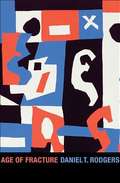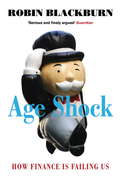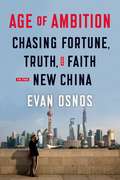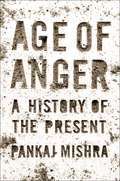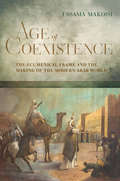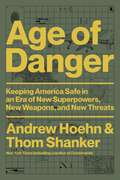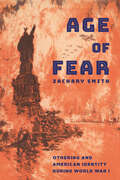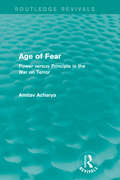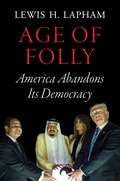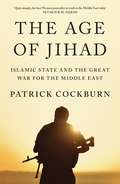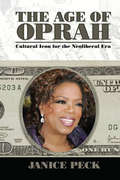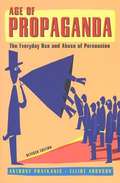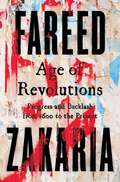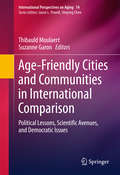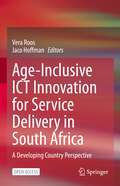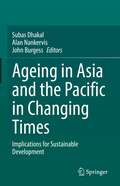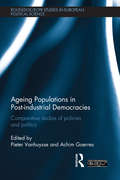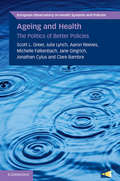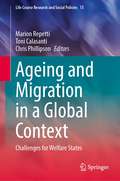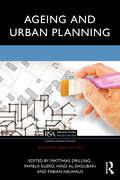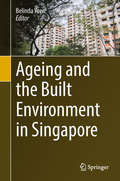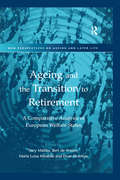- Table View
- List View
Age Of Fracture
by Daniel T. RodgersIn the last quarter of the twentieth century, the ideas that most Americans lived by started to fragment. Mid-century concepts of national consensus, managed markets, gender and racial identities, citizen obligation, and historical memory became more fluid. Flexible markets pushed aside Keynesian macroeconomic structures. Racial and gender solidarity divided into multiple identities; community responsibility shrank to smaller circles. In this wide-ranging narrative, Daniel Rodgers shows how the collective purposes and meanings that had framed social debate became unhinged and uncertain. Age of Fracture offers a powerful reinterpretation of the ways in which the decades surrounding the 1980s changed America. Through a contagion of visions and metaphors, on both the intellectual right and the intellectual left, earlier notions of history and society that stressed solidity, collective institutions, and social circumstances gave way to a more individualized human nature that emphasized choice, agency, performance, and desire. On a broad canvas that includes Michel Foucault, Ronald Reagan, Judith Butler, Charles Murray, Jeffrey Sachs, and many more, Rodgers explains how structures of power came to seem less important than market choice and fluid selves. Cutting across the social and political arenas of late-twentieth-century life and thought, from economic theory and the culture wars to disputes over poverty, color-blindness, and sisterhood, Rodgers reveals how our categories of social reality have been fractured and destabilized. As we survey the intellectual wreckage of this war of ideas, we better understand the emergence of our present age of uncertainty.
Age Shock
by Robin BlackburnMost countries face the future with an ageing population, yet most governments are cutting back on pensions and the care services needed by the elderly. Robin Blackburn exposes the perverse reasoning and special interests which have combined to produce this nonsensical state of affairs. This updated paperback edition of Age Shock includes a new preface explaining why the credit crunch and eurozone crisis have had such a devastating impact and outlining a way to guarantee decent pensions and care provision.
Age of Ambition: Chasing Fortune, Truth, and Faith in the New China
by Evan OsnosWinner of the 2014 National Book Award in nonfiction. An Economist Best Book of 2014. A vibrant, colorful, and revelatory inner history of China during a moment of profound transformation From abroad, we often see China as a caricature: a nation of pragmatic plutocrats and ruthlessly dedicated students destined to rule the global economy-or an addled Goliath, riddled with corruption and on the edge of stagnation. What we don't see is how both powerful and ordinary people are remaking their lives as their country dramatically changes  As the Beijing correspondent for The New Yorker, Evan Osnos was on the ground in China for years, witness to profound political, economic, and cultural upheaval. In Age of Ambition, he describes the greatest collision taking place in that country: the clash between the rise of the individual and the Communist Party's struggle to retain control. He asks probing questions: Why does a government with more success lifting people from poverty than any civilization in history choose to put strict restraints on freedom of expression? Why do millions of young Chinese professionals-fluent in English and devoted to Western pop culture-consider themselves "angry youth," dedicated to resisting the West's influence? How are Chinese from all strata finding meaning after two decades of the relentless pursuit of wealth? Writing with great narrative verve and a keen sense of irony, Osnos follows the moving stories of everyday people and reveals life in the new China to be a battleground between aspiration and authoritarianism, in which only one can prevail.
Age of Anger: A History of the Present
by Pankaj MishraOne of our most important public intellectuals reveals the hidden history of our current global crisisHow can we explain the origins of the great wave of paranoid hatreds that seem inescapable in our close-knit world—from American shooters and ISIS to Donald Trump, from a rise in vengeful nationalism across the world to racism and misogyny on social media? In Age of Anger, Pankaj Mishra answers our bewilderment by casting his gaze back to the eighteenth century before leading us to the present.He shows that as the world became modern, those who were unable to enjoy its promises—of freedom, stability, and prosperity—were increasingly susceptible to demagogues. The many who came late to this new world—or were left, or pushed, behind—reacted in horrifyingly similar ways: with intense hatred of invented enemies, attempts to re-create an imaginary golden age, and self-empowerment through spectacular violence. It was from among the ranks of the disaffected that the militants of the nineteenth century arose—angry young men who became cultural nationalists in Germany, messianic revolutionaries in Russia, bellicose chauvinists in Italy, and anarchist terrorists internationally.Today, just as then, the wide embrace of mass politics and technology and the pursuit of wealth and individualism have cast many more billions adrift in a demoralized world, uprooted from tradition but still far from modernity—with the same terrible results.Making startling connections and comparisons, Age of Anger is a book of immense urgency and profound argument. It is a history of our present predicament unlike any other.
Age of Coexistence: The Ecumenical Frame and the Making of the Modern Arab World
by Ussama MakdisiToday’s headlines paint the Middle East as a collection of war-torn countries and extremist groups consumed by sectarian rage. Ussama Makdisi’s Age of Coexistence reveals a hidden and hopeful story that counters this clichéd portrayal. It shows how a region rich with ethnic and religious diversity created a modern culture of coexistence amid Ottoman reformation, European colonialism, and the emergence of nationalism. Moving from the nineteenth century to the present, this groundbreaking book explores, without denial or equivocation, the politics of pluralism during the Ottoman Empire and in the post-Ottoman Arab world. Rather than judging the Arab world as a place of age-old sectarian animosities, Age of Coexistence describes the forging of a complex system of coexistence, what Makdisi calls the “ecumenical frame.” He argues that new forms of antisectarian politics, and some of the most important examples of Muslim-Christian political collaboration, crystallized to make and define the modern Arab world. Despite massive challenges and setbacks, and despite the persistence of colonialism and authoritarianism, this framework for coexistence has endured for nearly a century. It is a reminder that religious diversity does not automatically lead to sectarianism. Instead, as Makdisi demonstrates, people of different faiths, but not necessarily of different political outlooks, have consistently tried to build modern societies that transcend religious and sectarian differences.
Age of Danger: Keeping America Safe in an Era of New Superpowers, New Weapons, and New Threats
by Andrew Hoehn Thom ShankerAn urgent look at how America's national security machine went astray and how it fails to keep us safe—and what we can do to fix it. Again and again, American taxpayers are asked to open their wallets and pay for a national security machine that costs $1 trillion operate. Yet time and time again, the US government gets it wrong on critical issues. So what can be done? Enter bestselling author Thom Shanker and defense expert Andrew Hoehn. With decades of national security expertise between them and access to virtually every expert, they look at what&’s going wrong in national security and how to make it go right. Age of Danger looks at the major challenges facing America—from superpowers like Russia and China to emerging threats like pandemics, cybersecurity, climate change, and drones—and reimagines the national security apparatus into something that can truly keep Americans safe. Weaving together expert analysis with exclusive interviews from a new generation of national security leaders, Shanker and Hoehn argue that the United States must create an industrial-grade, life-saving machine out of a system that, for too long, was focused only on deterring adversaries and carrying out global military operations. It is a timely and crucial call to action—a call that if heeded, could save Americans lives, money, and our very future on the global stage.
Age of Entanglement
by Kris Manjapra"Age of Entanglement "explores patterns of connection linking German and Indian intellectuals from the nineteenth century to the years after the Second World War. Kris Manjapra traces the intersecting ideas and careers of a diverse collection of individuals from South Asia and Central Europe who shared ideas, formed networks, and studied one another's worlds. Moving beyond well-rehearsed critiques of colonialism towards a new critical approach, this study recasts modern intellectual history in terms of the knotted intellectual itineraries of seeming strangers. Collaborations in the sciences, arts, and humanities produced extraordinary meetings of German and Indian minds. Meghnad Saha met Albert Einstein, Stella Kramrisch brought the Bauhaus to Calcutta, and Girindrasekhar Bose began a correspondence with Sigmund Freud. Rabindranath Tagore traveled to Germany to recruit scholars for a new Indian university, and the actor Himanshu Rai hired director Franz Osten to help establish movie studios in Bombay. These interactions, Manjapra argues, evinced shared responses to the cultural and political hegemony of the British empire. Germans and Indians hoped to find in one another the tools needed to disrupt an Anglocentric world order. As Manjapra demonstrates, transnational intellectual encounters are not inherently progressive. From Orientalism and Aryanism to socialism and scientism, German-Indian entanglements were neither necessarily liberal nor conventionally cosmopolitan, often characterized as much by manipulation as by cooperation. "Age of Entanglement "underscores the connections between German and Indian intellectual history, revealing the characteristics of a global age when the distance separating Europe and Asia seemed, temporarily, to disappear.
Age of Fear: Othering and American Identity during World War I
by Zachary SmithFear can be more dangerous than the threats we think loom over us—how Germans and German Americans were perceived as a dangerous enemy during World War I.Although Americans have long celebrated their nation's diversity, they also have consistently harbored suspicions of foreign peoples both at home and abroad. In Age of Fear, Zachary Smith argues that, as World War I grew more menacing and the presumed German threat loomed over the United States, many white "Anglo-Saxon" Americans grew increasingly concerned about the vulnerability of their race, culture, and authority. Consequently, they directed their long-held apprehensions over ethnic and racial pluralism onto their German neighbors and overseas enemies whom they had once greatly admired.Smith examines the often racially tinged, apocalyptic arguments made during the war by politicians, propaganda agencies, the press, novelists, and artists. He also assesses citizens' reactions to these messages and explains how the rise of nationalism in the United States and Europe acted as a catalyst to hierarchical racism. Germans in both the United States and Europe eventually took the form of the proverbial "Other," a dangerous, volatile, and uncivilized people who posed an existential threat to the nation and all that Anglo-Saxon Americans believed themselves to be. Exploring what the Great War meant to a large portion of the white American population while providing a historic precedent for modern-day conceptions of presumably dangerous foreign Others, Age of Fear is a compelling look at how the source of wartime paranoia can be found in deep-seated understandings of racial and millennial progress.
Age of Fear: Power Versus Principle in the War on Terror (Routledge Revivals)
by Amitav AcharyaFirst published in 2004 in the immediate wake of the September 11 terrorist attacks, this is an accessible commentary intended to provoke thought and debate on the topic of terrorism. In a collection of challenging essays, questions consider the causes of terrorism and why post-modern terrorism is different. The essays are divided into three key sections, first investigating the civilizational roots and dimensions of contemporary terrorism, next examining the Bush administration’s approach, and finally, considering the complex and changing relationship between fear and freedom. Written by a leading scholar in Middle East and Asian Studies, this comprehensive reissue will be of particular value to students of international relations and terrorism studies, as well as the more general reader with an interest in the global issues faced in the age of contemporary terrorism.
Age of Folly: America Abandons Its Democracy
by Lewis H. LaphamAmerica's leading essayist on the frantic retreat of democracy, in the fire and smoke of the war on terrorIn twenty-five years of imperial adventure, America has laid waste to its principles of democracy. The self-glorifying march of folly steps off at the end of the Cold War, in an era when delusions of omnipotence allowed the market to climb to virtual heights, while society was divided between the selfish and frightened rich and the increasingly debt-ridden and angry poor. The new millennium saw the democratic election of an American president nullified by the Supreme Court, and the pretender launching a wasteful, vainglorious and never-ending war on terror, doomed to end in defeat and the loss of America's prestige abroad.All this culminates in the sunset swamp of the 2016 election--a farce dominated by Donald Trump, a self-glorifying photo-op bursting star-spangled bombast in air. This spectacle would be familiar to Aristotle, whose portrayal of the "prosperous fool" describes a class of people who "consider themselves worthy to hold public office, for they already have the things that give them a claim to office."From the Hardcover edition.
Age of Icons
by Martijn Konings Gavin FridellCelebrities are increasingly front and centre in public debates on everything from solving world poverty to halting genocide, confronting obesity, and finding spiritual contentment. Bono, Bill Gates, Al Gore, Bob Geldof, Oprah, Madonna, and Angelina Jolie are just some of the entertainers, politicians, pundits, elite business people, and policy-makers whose highly visible political activism has become an integral part of their public personas.These pop icons tend to be celebrated as "philanthrocapitalists" with a unique ability to remedy the world's problems. However, as Age of Icons demonstrates, the solutions these icons promote for addressing global injustice, when examined critically, can be seen to work through the very same institutions that create these problems in the first place.This volume assesses the growing role of popular icons in the construction of a culture that appears to incorporate a critical attitude towards the capitalist experience while, in fact, legitimizing the neoliberal character of the modern world. It will be an eye-opening read for anyone interested in the juncture between current events and celebrity culture.
Age of Jihad: Islamic State and the Great War for the Middle East
by Patrick CockburnFrom the award-winning author of The Rise of Islamic State, the essential story of the Middle East's disintegrationThe Age of Jihad charts the turmoil of today's Middle East and the devastating role the West has played in the region from 2001 to the present. Beginning with the US-led invasion of Afghanistan, Cockburn explores the vast geopolitical struggle that is the Sunni-Shia conflict, a clash that shapes the war on terror, western military interventions, the evolution of the insurgency, the civil wars in Yemen, Libya and Syria, the Arab Spring, the fall of regional dictators, and the rise of Islamic State. As Cockburn shows in arresting detail, Islamic State did not explode into existence in Syria in the wake of the Arab Spring, as conventional wisdom would have it. The organization gestated over several years in occupied Iraq, before growing to the point where it can threaten the stability of the whole region. Cockburn was the first Western journalist to warn of the dangers posed by Islamic State. His originality and breadth of vision make The Age of Jihad the most in-depth analysis of the regional crisis in the Middle East to date.From the Hardcover edition.
Age of Oprah: Cultural Icon for the Neoliberal Era (Media and Power)
by Janice PeckOver the last two decades Oprah Winfrey's journey has taken her from talk show queen to-as Time Magazine has asserted-"one of the most important figures in popular culture." Through her talk show, magazine, website, seminars, charity work, and public appearances, her influence in the social, economic, and political arenas of American life is considerable and until now, largely unexamined. In The Age of Oprah, media scholar and journalist Janice Peck traces Winfrey's growing cultural impact and illustrates the fascinating parallels between her road to fame and fortune and the political-economic rise of neoliberalism in this country. While seeking to understand Oprah's ascent to the near- iconic status that she enjoys today, Peck's book provides a fascinating window into the intersection of American politics and culture over the past quarter century.
Age of Propaganda: The Everyday Use and Abuse of Persuasion
by Elliot Aronson Anthony H. PratkanisAmericans create 57% of the world's advertising while representing only 6% of its population; half of our waking hours are spent immersed in the mass media. Persuasion has always been integral to the democratic process, but increasingly, thoughtful discussion is being replaced with simplistic soundbites and manipulative messages. Drawing on the history of propaganda as well as on contemporary research in social psychology, Age of Propaganda shows how the tactics used by political campaigners, sales agents, advertisers, televangelists, demagogues, and others often take advantage of our emotions by appealing to our deepest fears and most irrational hopes, creating a distorted vision of the world we live in. This revised and updated edition includes coverage of the Clinton/Lewinsky scandal, recent election campaigns, talk radio, teen suicide, U. F. O. abductions, the Columbine shootings, and novel propaganda tactics based on hypocrisy and false allegations.
Age of Revolutions: Progress and Backlash from 1600 to the Present
by Fareed ZakariaThe CNN host and best-selling author explores the revolutions—past and present—that define the polarized and unstable age in which we live. <p><p> Populist rage, ideological fracture, economic and technological shocks, war, and an international system studded with catastrophic risk—the early decades of the twenty-first century may be the most revolutionary period in modern history. But it is not the first. Humans have lived, and thrived, through more than one great realignment. What are these revolutions, and how can they help us to understand our fraught world? <p><p> In this major work, Fareed Zakaria masterfully investigates the eras and movements that have shaken norms while shaping the modern world. Three such periods hold profound lessons for today. First, in the seventeenth-century Netherlands, a fascinating series of transformations made that tiny land the richest in the world—and created politics as we know it today. Next, the French Revolution, an explosive era that devoured its ideological children and left a bloody legacy that haunts us today. Finally, the mother of all revolutions, the Industrial Revolution, which catapulted Great Britain and the US to global dominance and created the modern world. <p><p> Alongside these paradigm-shifting historical events, Zakaria probes four present-day revolutions: globalization, technology, identity, and geopolitics. For all their benefits, the globalization and technology revolutions have produced profound disruptions and pervasive anxiety and our identity. And increasingly, identity is the battlefield on which the twenty-first century’s polarized politics are fought. All this is set against a geopolitical revolution as great as the one that catapulted the United States to world power in the late nineteenth century. Now we are entering a world in which the US is no longer the dominant power. As we find ourselves at the nexus of four seismic revolutions, we can easily imagine a dark future. But Zakaria proves that pessimism is premature. If we act wisely, the liberal international order can be revived and populism relegated to the ash heap of history. <p><p> As few public intellectuals can, Zakaria combines intellectual range, deep historical insight, and uncanny prescience to once again reframe and illuminate our turbulent present. His bold, compelling arguments make this book essential reading in our age of revolutions. <p> <b>New York Times Bestseller</b>
Age of Secession
by Griffiths Ryan D.What are the factors that determine how central governments respond to demands for independence? Secessionist movements are numerous and quite varied in form, but the chief obstacle to their ambitions is the state itself, which can deny independence demands, deploy force if need be, and request that the international community respect its territorial integrity by not recognizing the breakaway region. Age of Secession focuses on this crucial but neglected moment in the life of a secessionist movement. Griffiths offers a novel theory using original data on secessionist movements between 1816 and 2011. He explains how state response is shaped by international and domestic factors, when conflict is likely, and why states have proliferated since 1945. He mixes quantitative methods with case studies of secessionist movements in the United Kingdom, Russia/Soviet Union, and India. This is an important book for anyone who wants to understand the phenomenon of secession.
Age-Friendly Cities and Communities in International Comparison: Political Lessons, Scientific Avenues, and Democratic Issues (International Perspectives on Aging)
by Thibauld Moulaert Suzanne GaronThe supportiverole of urban spaces in active aging is explored on a world scale in thisunique resource, using the WHO's Age-Friendly Cities and Community model. Casestudies from the U. S. , Canada, Australia, Hong Kong, and elsewhere demonstratehow the model translates to fit diverse social, political, and economic realitiesacross cultures and continents, ways age-friendly programs promote seniorempowerment, and how their value can be effectively assessed. Age-friendlycriteria for communities are defined and critiqued while extensive empiricaldata describe challenges as they affect elders globally and how environmentalsupport can help meet them. These chapters offer age-friendly cities as acorrective to the overemphasis on the medical aspects of elders' lives, and shouldinspire new research, practice, and public policy. Included in thecoverage: A critical review of the WHO Age-Friendly Cities Methodology and its implementation. Seniors' perspectives on age-friendly communities. The implementation of age-friendly cities in three districts of Argentina. Age-friendly New York City: a case study. Toward an age-friendly European Union. Age-friendliness, childhood, and dementia: toward generationally intelligent environments. With its balanceof attention to universal and culture-specific concerns, Age-Friendly Cities and Communities in International Comparisonwill be of particular interest to sociologists, gerontologists, and policymakers. "Given the rapid adoption ofthe age-friendly perspective, following its development by the World HealthOrganization, the critical assessment offered in this volume is especiallywelcome". Professor ChrisPhillipson, University of Manchester
Age-Inclusive ICT Innovation for Service Delivery in South Africa: A Developing Country Perspective
by Vera Roos Jaco HoffmanThis book presents the select peer-reviewed proceedings of the International Conference on Futuristic Advancements in Materials, Manufacturing and Thermal Sciences (ICFAMMT 2022). It provides an overview of the latest research in the areas of fundamentals of material science and metallurgy, material processing, mechanical properties and material characterizations, composite materials, nanomaterials, applications of materials, advanced engineering materials, technologies for space, nuclear and aerospace applications, optimization of materials for required properties, resent trends in materials science and metallurgy. The book will be useful for researchers and professionals working in the field of material science and metallurgy.
Ageing Asia and the Pacific in Changing Times: Implications for Sustainable Development
by John Burgess Subas Dhakal Alan NankervisThis book demonstrates that there are wide-ranging potential challenges in addressing issues associated with ageing populations in both developed and developing countries of the region. This book brings together local, national and regional perspectives on the ageing population and sustainable development nexus in selected countries in the Asia Pacific region. The countries selected in this book include a mix of developed and developing economies that all reflect strong trade, investment and migration linkages. While the Asia Pacific region is forecast to enjoy high growth in the coming decade, a recurring common policy challenge is addressing the ‘demographic time bomb’ posed by ageing populations and workforces (Montague et al., 2017). Consequently, this book focuses on strategic policies and practices of multiple stakeholders, primarily: governments, industry and education systems, together with, the range of aged care services providers – in more effectively addressing these key socio-economic challenges associated with the ageing population for sustainable development.
Ageing Populations in Post-Industrial Democracies: Comparative Studies of Policies and Politics (Routledge/ECPR Studies in European Political Science)
by Pieter Vanhuysse Achim GoerresMost advanced democracies are currently experiencing accelerated population ageing, which fundamentally changes not just their demographic composition; it can also be expected to have far-reaching political and policy consequences. This volume brings together an expert set of scholars from Europe and North America to investigate generational politics and public policies within an approach explicitly focusing on comparative political science. This theoretically unified text examines changing electoral policy demands due to demographic ageing, and features analysis of USA, UK, Japan, Germany, Italy and all major EU countries. As the first sustained political science analysis of population ageing, this monograph examines both sides of the debate. It examines the actions of the state against the interests of a growing elderly voting bloc to safeguard fiscal viability, and looks at highly-topical responses such as pension cuts and increasing retirement age. It also examines the rise of ‘grey parties’, and asks what, if anything, makes such pensioner parties persist over time, in the first ever analysis of the emergence of pensioner parties in Europe. Ageing Populations in Post-Industrial Democracies will be of interest to students and scholars of European politics, and to those studying electoral and social policy reform. Official publication date 1st January 2012.
Ageing and Health: The Politics of Better Policies (European Observatory on Health Systems and Policies)
by Scott L. Greer Clare Bambra Jonathan Cylus Julia Lynch Jane Gingrich Aaron Reeves Michelle FalkenbachOne of the most important political and economic challenges facing Europe and elsewhere is the ageing of societies. Must ageing populations create conflict between generations and crisis for health systems? Our answer is no. The problem is not so much demographic change as the political and policy challenge of creating fair, sustainable and effective policies for people of all ages. This book, based on a large European Observatory study, uses new evidence to challenge some of the myths surrounding ageing and its effects on economies and health systems. Cataclysmic views of population ageing are often based on stereotypes and anecdotes unsupported by evidence. How we address ageing societies is a choice. Societies can choose policies that benefit people of all ages, promoting equity both within and between generations, and political coalitions can be built to support such policies. This title is available as Open Access on Cambridge Core.
Ageing and Migration in a Global Context: Challenges for Welfare States (Life Course Research and Social Policies #13)
by Chris Phillipson Marion Repetti Toni CalasantiThis book brings together two major trends influencing economic and social life: population ageing on the one side, and migration on the other. Both have assumed increasing importance over the course of the 20th and into the 21st century. The book offers a unique interdisciplinary perspective on the challenges posed by the globalisation of the life course to welfare states’ old age and family policies. Through a variety of case studies, it covers a wide range of migration scenarios: those who migrate in later life; migrants from earlier years who age in place; and old people who hire migrant caregivers. It shows how both local and global economic inequalities intersect to frame interactions between ageing, migration, and family support. Across a wide variety of situations, it highlights that migration can both create risks for older people, but also serve as an answer to ageing-related social, economic, and health risks. The book explores tensions between national and global contexts in experiences of migration across the life course. As such this book offers a fascinating read to scholars, students, practitioners, and policy makers in the fields of aging, migration, life course, and population health.
Ageing and Urban Planning (Regions and Cities)
by Fabian Neuhaus Matthias Drilling Hind Al-Shoubaki Pamela SueroAgeing and Urban Planning provides a critical analysis of urban planning in the face of demographic change. It emphasises the importance of international approaches and practices to address age-friendly planning. This process requires collaboration between professionals and the community, going beyond mere functionality to connect the micro and macro scales at the city, region, nation, and the global level.With an interdisciplinary and intersectional approach, the book draws on analytical lenses from architecture, gerontology, geography, sociology, and social and urban planning. It offers a thorough critique of popular narratives surrounding ageing and urban planning while presenting diverse case studies on a variety of spatial scales. The volume also covers the history of urban design for ageing and inclusivity in planning governance, as well as a critical look at the concept of "ageing in place" from the perspective of urban planning. The book offers a comprehensive selection of in-depth photos and figures from urban design studios, planning processes, and real-life scenarios. This collection provides a unique network of inspiring ideas. The book ultimately seeks to supplement the debate and promote a broader reflection about the transformations required in urban planning, given the opportunities and challenges related to a world with increased longevity.This valuable resource is recommended for advanced students, researchers, and policymakers in the fields of urban planning, age-related disciplines and professions, and social policy.
Ageing and the Built Environment in Singapore
by Belinda YuenThis book contains a collection of studies that have been conducted among older residents in Singapore. Different methods, from surveys to crowd sourcing, have been used to investigate the older adults’ lived experiences and social participation in the residential environment. The findings reveal that older residents interact with the built environment in ways that reflect their changing capabilities and lifestyles. Since the built environment – where we live and go – can have an important impact on our daily lives, especially among older people, understanding these experiences and perceived needs is important to help older individuals age within their community.
Ageing and the Transition to Retirement: A Comparative Analysis of European Welfare States (New Perspectives on Ageing and Later Life)
by Bert De Vroom Einar ØverbyeThere are two conflicting trends in Europe: a demographic shift towards population ageing, and a massive decrease in the labour force participation of older workers (aged 50 years and over). This captivating book offers a refined and authoritative understanding of these trends and the two socio-economic concerns of most European welfare states that have been re-enforced as a consequence. These are: the increasing costs for welfare states to finance 'pathways' from employment to official retirement, and the threat of labour market shortages in the near future as a result of both the ageing process and the early exit of older workers. A variety of new policy initiatives can be observed emerging from these changes in many European countries - this book examines the different welfare state arrangements in nine EU countries plus Hungary, Slovenia and Norway. It considers ways of integrating older workers in the labour market along with differing perspectives on the relation between ageing and work.
